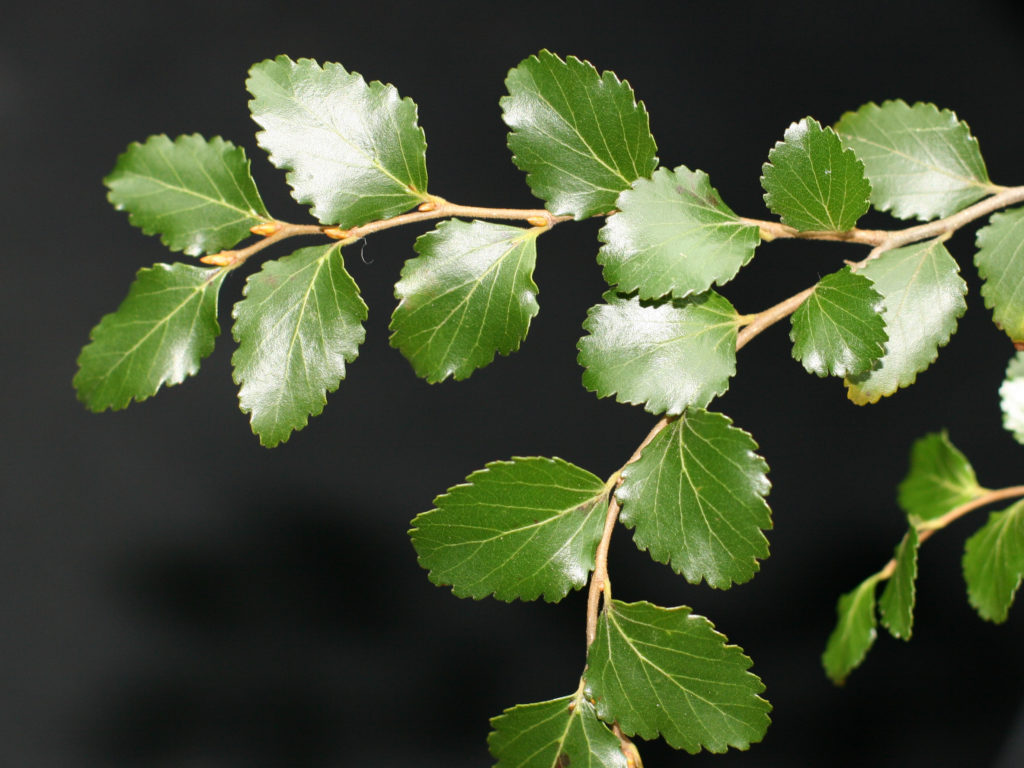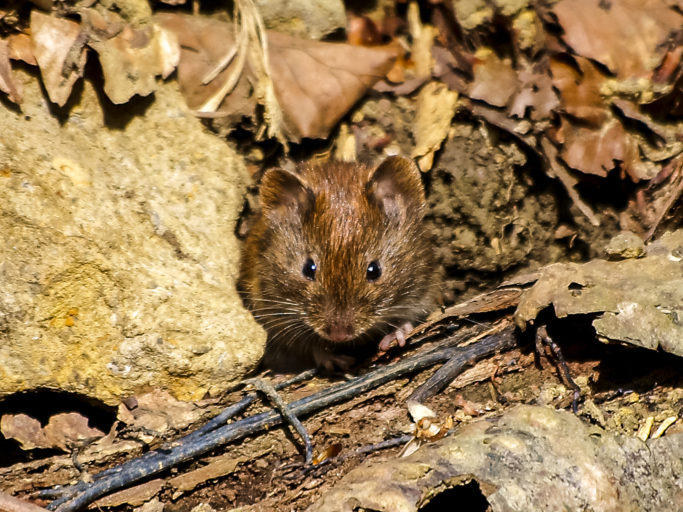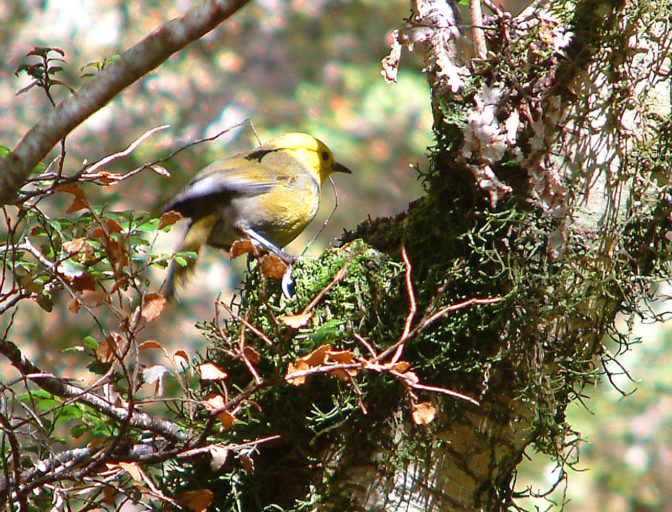In the past there’s been some uncertainty over the effectiveness of large-scale aerial 1080 operations to control mice and little is known about its effect on hedgehogs. Recent trail camera monitoring of mammal predators before and after a control operation in the Blue Mountains, West Otago, suggests the operation not only controlled rats, stoats and possums but also had an impact on mice and hedgehogs.

Peter Dilks, Tim Sjoberg and Elaine Murphy from DOC Christchurch and Centre for Wildlife Management & Conservation, Lincoln University, describe their research findings in an article published earlier this year in the New Zealand Journal of Ecology.
“In 2014, there was widespread beech seeding throughout the South Island’s beech forests, and stoat and rodent population irruptions were predicted as a consequence. The Department of Conservation (DOC) undertook the ‘Battle for our Birds’ campaign in which aerial 1080 operations were undertaken over selected areas that held vulnerable wildlife populations. The aim of our study was to use trail cameras to monitor the fate of a range of pest mammal species, primarily stoats, ship rats and possums, through an aerial 1080 operation in the Blue Mountains, West Otago, one of DOC’s ‘Battle for our Birds’ sites.”
The study was carried out in 400 hectares of beech forest in the Rankleburn Forest, Blue Mountains, West Otago.

“The Rankleburn Forest comprises 6907 ha of native bush dominated by silver beech (Lophozonia menziesii) on rolling hill-country, marked by tributaries carved into steep-sided gullies and with tussock land on the alpine areas (up to 1019 m). The native forest is managed by DOC and is surrounded by forestry plantations of Douglas fir and radiata pine with logging roads along eastern ridges for forestry management and harvesting access.”
The Blue Mountains is also a Recreational Hunting Area with a large herd of fallow deer, and is popular with deer hunters from around the South Island, so deer repellent was used in the operation.
“The aerial 1080 operation covered 4618 hectares of native forest with toxin applied over the entire study area. Pre-feed cereal pellets were aerially sown on 6th November 2014 at a rate of 1 kg per hectare. Toxic cereal pellets (0.15% 1080, 6 g RS5 cereal baits from Animal Control Products Ltd) were aerially applied on the 2nd December 2014 at a rate of 1.5 kg per hectare. Epro Deer repellent was used on the pre-fed and toxic pellets.”
Trap boxes – without traps – and trail cameras were used to monitor target mammal predators in the 1080 control area. The trap boxes were baited with fresh rabbit and a hen’s egg.
“We used 26 wooden DOC 200 trap boxes with baffles but without traps (‘stations’). These trap boxes were placed in a grid, 400 m apart on each line and 800 m between lines. Stations also covered the perimeter of the study area at 400-m intervals. Twenty-five LTL Acorn 5210A cameras and one Bushnell Trophy camera, which were movement and infrared activated, were deployed to record activity around the stations. Upon activation they recorded a 30 second video, with a 30 second delay before a further recording could be made. Cameras operated for 136 days; 98 before and 38 days after the toxin application.”
“Cameras were set up and the stations baited on the 27th August 2014, with camera servicing and re-baiting undertaken on the 16th September, 22nd October and 16th December. Cameras were collected on the 7th of January 2015. The SD cards and batteries were changed at each servicing, and all video clips were viewed and the identities of mammal and bird species were tabulated.”
One camera was faulty and another was stolen, but the remaining cameras operated effectively throughout the study, with space remaining on their memory cards at the end of the study period.
“Of the 26 cameras, 24 were present over the entire 136-day study; 98 days before and 38 days after the poison operation. The number of videos recording an animal per camera ranged between 53 and 443. We gathered 4792 videos recording animals.”
Animal species recorded included mice (831 visits), stoats (540 visits), possums (439), hedgehogs (536), rats (478), hares (72), deer (35) and weasels (33 visits) – along with 13 visits from Homo sapiens – people. A variety of different introduced and native birds were also ‘caught on camera’.
“Following the major beech masting event in 2014, some cameras recorded videos of mixed-species flocks of several hundred finches feeding on the prolific beech seed.”

Prior to the poison operation, stoats and rats were regularly recorded on cameras throughout the study area.
“Rats were almost always solitary, but stoats were twice recorded in family groups of up to six animals in November. The aerial 1080 operation appeared to have an immediate effect on all the mammal pest species. The number of cameras recording stoats, rats, mice and hedgehogs were significantly different in the 13-day re-baited period after the operation than the re-baited period before the operation.”
The study was not designed as a controlled experiment. There were no non-treatment sites, but the use of trail cameras did allow a detailed monitoring of the effectiveness of the management operation.
“Aerially applied 1080 appeared to be extremely effective at killing the targeted pest species. Although 1080 can be effective for possum and rat control through primary poisoning and stoat control through secondary poisoning, the speed at which this happened in our study was unexpected. No stoats or rats were recorded the day immediately after the operation, and none returned by the time we finished our monitoring (38 days after the operation).”
Mice, possums and hedgehogs were also controlled by the operation.
“The use of trail cameras allowed for continuous monitoring of the pest populations and indicated how quickly they were reduced in abundance. An unexpected result of the camera monitoring was that hedgehogs were found to be common throughout the beech forest, as they have been considered less abundant in higher country. In the past, hedgehog control has been largely undertaken by trapping and it was not known previously that aerial 1080 could be such an effective control method. Hedgehogs are omnivorous so could have died from primary and/or secondary poisoning.”
Previously research has shown that aerial operations using brodifacoum cereal baits result in high hedgehog mortality, but in another experiment, no monitored hedgehogs died during an intensive four-month brodifacoum bait station operation.
“These results suggest primary poisoning may be the main route as hedgehogs are unlikely to be able to access bait stations. If aerial 1080 operations routinely control hedgehogs along with possums, rodents and stoats this would be of real conservation benefit. However, hedgehogs hibernate in colder areas in winter, so in such areas, winter 1080 operations might not be expected to control them.”
Although trail cameras proved effective in monitoring the success of the aerial 1080 operation, the costs involved in such monitoring are high.

“The initial setup cost of camera plus security case and locks is substantial. It is difficult to compare the effectiveness of trail cameras with tracking tunnels for detecting and monitoring predators in the study area due to the huge difference in effort between methods; our cameras recorded continuously compared with one-night monitoring for rodents and three nights for mustelids in each tracking session.”
“There were four rodent tracking lines in our study area and in the November before the operation, the one day tracking rate was 10% for rats and 38% for mice. About two weeks after the 1080 operation, tracking rates dropped to 0% for both rats and mice. There were three mustelid tracking lines within the study area and the three-day mean mustelid tracking rate per line was 37% in November pre-operation, with 100% of lines tracked, and this also dropped to 0% after the operation.”
The news was also good for bird abundance after the control operation – especially for mohua which are tree-cavity nesters and therefore very vulnerable to mammal predators.
“In our study, there was no evidence of a decrease in bird abundance in the four weeks after the aerial 1080 operation using cameras as a monitoring method. Mohua have been monitored in our study area since 2007. The October 2014 mohua counts (before the aerial 1080 operation) suggested a decline in mohua numbers from the year before, but the count in 2015 (after the aerial 1080 operation) was the highest since counts began in 2007.”
There was also no decline in deer numbers detected.
The full research paper is published in the New Zealand Journal of Ecology and is freely available online.
Effectiveness of aerial 1080 for control of mammal pests in the Blue Mountains, New Zealand (2020)

